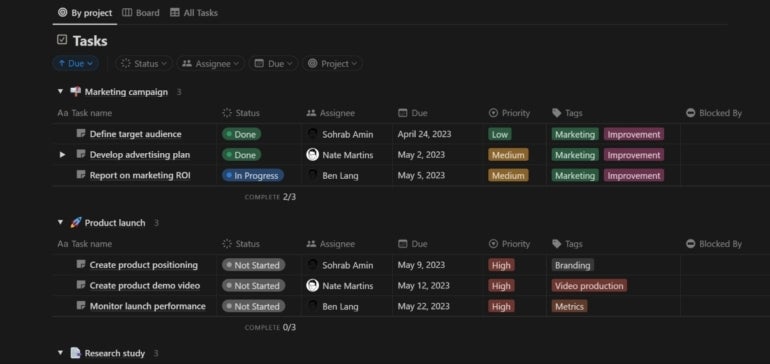
Notion and Asana are excellent options for organizations to streamline their task management. Notion is a project and task management tool that helps users work together to plan, track and manage their work tasks in one accessible digital place. On the other hand, Asana offers a solution that enables users to build and manage their project workflows. The system’s key features help automate and organize users’ tasks, schedules and goals.
Jump to:
| Feature | Notion | Asana |
|---|---|---|
| Templates | Yes | Yes |
| Multiple views | Yes | Yes |
| Real-time collaboration | Yes | Yes |
| Third-party integrations | 70+ | 350+ |
| Platforms | Web, macOS, Windows, iOS android | Web, Windows, Mac, iOS android |
| Starting price | From$8/user/month | From $10.99/user/month |
Pricing is always a significant factor when selecting premium software of any kind, let alone project management software. Both Notion and Asana offer a range of pricing options to cater to different needs. Here’s a head-to-head comparison as both offer four pricing tiers each.
Both tools offer a free plan that targets individuals and teams. Notion offers unlimited blocks, which are pieces of content you add to a page, for individuals and a limited block trial for teams. You can invite up to 10 guests. The plan also includes basic page analytics and a 7-day page history.
As for Asana, the Basic plan is free forever and targets individuals or teams that are new to project management. It offers unlimited tasks, projects, messages and a 100MB per file storage limit. You can collaborate with up to 15 teammates. It’s, however, limited to three project views.
Notion Plus costs $8 per user per month when billed annually and $10 when billed monthly. It offers unlimited blocks for teams, unlimited file uploads and a 30-day page history, and you can invite up to 100 guests. It costs almost $3 less than Asana’s premium plan when billed annually.
Asana Premium costs $10.99 per user per month when billed annually and $13.49 when billed monthly. It offers features like Timeline, Workflow Builder and unlimited dashboards. Custom fields and unlimited free guests are also included.
Both software tools have a pricing tier called Business. Notion Business is $15 per user per month when billed annually and $18 when billed monthly. It includes advanced page analytics, 90-day page history and private teamspaces.
On the other hand, Asana Business is priced at $24.99 per user/month when billed annually and $30.49 when billed monthly. It includes everything in Premium, plus features like Portfolios, Goals and Workload view. Advanced integrations with Salesforce, Adobe Creative Cloud, Tableau and Power BI are also available.
As both tools have Enterprise plans, neither has prices disclosed, as they encourage prospective clients to contact them for a custom quote.
Comparing all the pricing tiers, it’s noticeable that Asana costs much more than Notion. This could be because, although both are project management tools, they have different focuses. Asana is more all-rounded while Notion is a tool that knows what it’s good at and doubles down on it. Notion offers more flexibility in terms of content creation and organization, while Asana focuses more on task and project management.
That being said, Asana is still more expensive than similar project management tools. Asana offers a 50% discount for nonprofit organizations, which is a nice touch for those who qualify.
Both platforms offer a good range of features in their free plans, but the real power is unlocked in the paid plans. Always consider the cost of additional integrations or add-ons. Be sure to always read the fine print. For example, Notion limits the number of blocks in the free plan, which might require an unexpected upgrade.
For a more in-depth analysis and feature list, you can refer to the full Notion review and full Asana review.
Notion offers a variety of templates to make sure that starting and managing a project is as intuitive a process as possible. These templates vary across categories like work, school, personal, projects, wiki and docs, where the projects category has 875 templates. Users can choose between Notion’s template (Figure A) options, which can help them through effective visual workflows.
Figure A
Asana also provides templates for managing and tracking projects and workloads with their system. These templates cover at least ten use cases, to make sure that its users can avoid starting projects from scratch whenever possible and easily scale their processes.
Notion provides a project roadmap and a shared, customizable screen where users can view their tasks by status. This can be displayed in multiple ways: by status, epics, sprints, tasks, epic calendar, tasks by engineer, etc. For easy organization, each item within the database has its page featuring relevant information. Users can also create pages inside pages to keep their related tasks bundled together.
Figure B
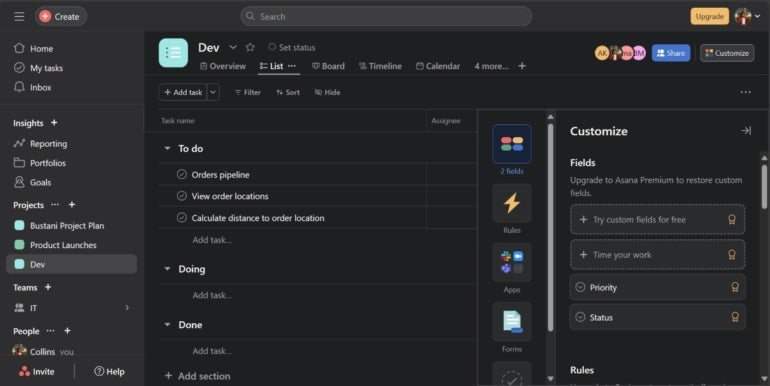
Asana’s project management software enables users to view their tasks, schedules, goals, reports and more. The shared calendar and workload visuals help users stay on track with their teams and their boards allow them to organize and track their work with transparency at each stage of their process. Users can generate to-do lists and timelines to manage their project tasks, subtasks and steps. In addition, Asana lets members set company goals and track their progress based on the work that supports them. Other visuals include project portfolios, inboxes, file views, teammate views (Figure B) and more.
Notion’s software contains several features to support collaboration between team members or approved individuals. Its real-time collaboration feature allows users to make changes and work together on the same project page at the same time. Adjustments are instantly updated within the system, so everyone can stay on track with the latest project statuses. The system can also provide smart notifications that inform users when they are mentioned in conversation. Additionally, the software’s integrations (Figure C) with other workplace platforms mean that users can be updated on collaboration tools within the Notion system. Examples of these integrations include Slack and Google Drive.
Figure C
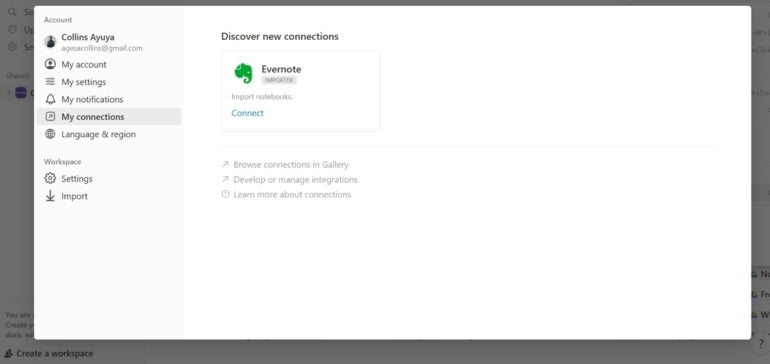
Asana project management software users can easily work together through the system’s collaboration features. The teammate view feature lets users understand their teammates’ workloads that are shared with them or are publicly accessible to their team. The system has messaging, commenting, project conversations and team conversations to connect users and simplify collaboration. “Likes” are a way for users to vote on or positively acknowledge comments or tasks within the system. All approvals are streamlined in Asana. Users can add teammates as followers on relevant tasks and admin controls let leaders manage their teams and team settings so everyone can access their necessary information, making collaboration more straightforward. It integrates (Figure D) with several third-party collaboration tools for easy access and use.
Figure D
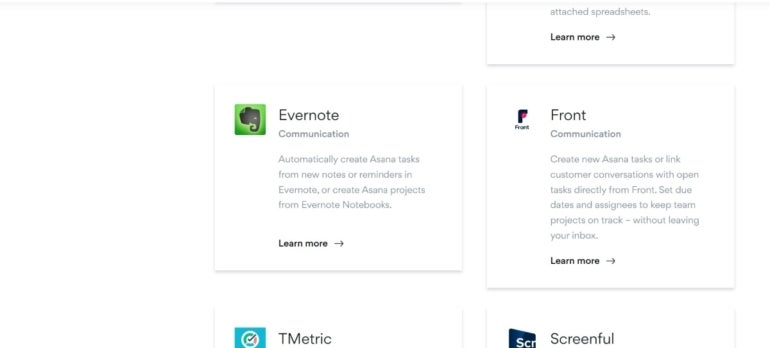
Notion’s project management software can be used via the web application or through a desktop or mobile app. Its compatible platforms include the web, macOS, Windows, iOS and Android. The software is SOC2 compliant with data encryption in transit and at rest, TLS everywhere and a 100% cloud-based architecture secured behind a VPC, so the programs are easily accessible and safe. Additional security measures include quarterly independent security audits. SAML single sign-on Enterprise, SCIM API Enterprise and granular permission levels, so users can feel secure about who can access their data and accounts.
Figure E
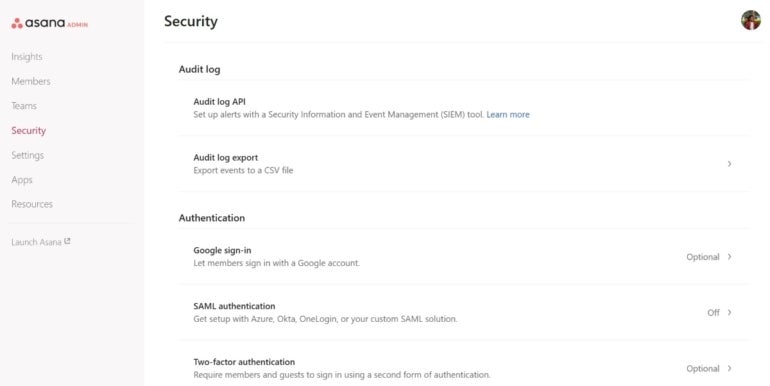
Asana’s software-as-a-service platform can be utilized through web, mobile apps or desktop applications. They offer an app for Windows and Mac desktops and iOS and Android mobile apps. Users’ information is secured with security controls and monitors, including password protection, routine security (Figure E) assessments, least privilege access and a public buy bounty program. Enterprise admins can benefit from two-factor authentication, SSO and SAML 2.0 for their organizations. The Asana infrastructure investments provide backups daily, regional backups and recovery procedures. Additionally, the software offers privacy controls, data governance features, global data residency options and Enterprise Key Management.
We tested both tools to get a first-hand feel of each and understand what each is good for and how they implement the features listed on their websites. Comparing the practical aspect to the information on their sites was followed by some verified user reviews to gauge the reception of these tools by real-world users and understand whether we shared similar impressions or challenges.
When choosing the right project management software, there are various factors to take into consideration.
It is important to think about what features would be most beneficial for your organization. For example, an organization that votes on many tasks might utilize the “Likes” feature within the Asana solution. On the other hand, the real-time collaboration features Notion’s product offers may be more beneficial for organizations that require multiple team members to edit files and tasks simultaneously. Also, you may benefit from looking at each product’s template options to see which ones would be more appealing.
By considering your organization’s needs and the features provided by each tool, you can determine which project management solution will serve you best.